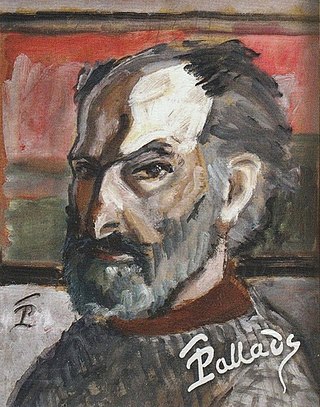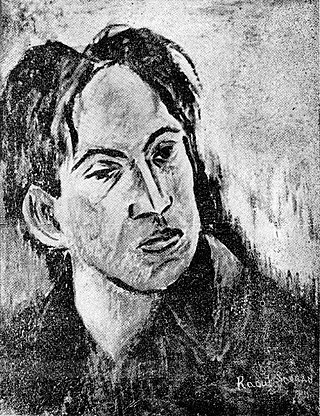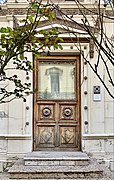
Bucharest is the capital and largest city of Romania. The metropolis stands on the River Dâmbovița in south-eastern Romania. Its population is officially estimated at 1.76 million residents within a greater metropolitan area of 2.3 million residents, which makes Bucharest the 8th most-populous city in the European Union. The city area measures 240 km2 (93 sq mi) and comprises 6 districts (Sectoare), while the metropolitan area covers 1,811 km2 (699 sq mi). Bucharest is a beta global city, a major cultural, political and economic hub, and the country's seat of government.

The Jewish Museum in Bucharest, Romania is located in the former Templul Unirea Sfântă synagogue, which survived World War II.

The National Museum of Art of Romania is located in the Royal Palace in Revolution Square, central Bucharest. It features collections of medieval and modern Romanian art, as well as the international collection assembled by the Romanian royal family.
The Zambaccian Museum in Bucharest, Romania is a museum in the former home of Krikor Zambaccian, a businessman and art collector. The museum was founded in the Dorobanți neighbourhood in 1947, closed by the Nicolae Ceaușescu regime in 1977, and re-opened in 1992. It is now a branch of The National Museum of Art of Romania. Its collection includes works by Romanian artists—including a masterful portrait of Zambaccian himself by Corneliu Baba—and works by several French impressionists. It is located not far from Piața Dorobanților on a street now renamed after Zambaccian.
Ignat Bednarik was a Romanian painter who worked in almost every genre of painting before devoting himself purely to watercolor. He was also interested in decorative art, design, interior decoration and book illustration. In his lifetime, he produced more than 3,000 works of art.

Theodor Pallady was a Romanian painter.

The Romanian National Opera, Bucharest is one of the four national opera and ballet companies of Romania. The company is headquartered in Bucharest, near the Cotroceni neighbourhood.

The Theodor Pallady Museum is a museum located at 22 Spătarului Street in Bucharest, Romania. Situated in one of the oldest surviving merchant houses in the city, it includes many works by the well-known Romanian painter Theodor Pallady, as well as a number of European and Oriental furniture pieces. Built in the second half of the 18th century, the house is named after its most illustrious owner, Iacob Melic.

The Museum of Art Collections is a branch of the National Museum of Art of Romania and is situated in Bucharest. It is located on Calea Victoriei no.111 at the corner of Calea Griviței, in Romanit Palace, the first section of which was built in 1822.

Theodor Aman was a Romanian painter, engraver and art professor. He mostly produced genre and history scenes.

Bucur Church is a is a Romanian Orthodox church located at 33 Radu Vodă Street, in Sector 4, Bucharest, Romania. It formerly served as the chapel for the Radu Vodă Monastery.

Raoul Șorban was a Romanian painter, journalist, writer, essayist, art historian, academic, and memoirist.

The National University of Arts in Bucharest is a university in Bucharest preparing students in fine arts. The National University of Arts is a higher education institution in Bucharest.

The Argeș County Museum is a government institution and visitor attraction based in Pitești, Romania. Formally inaugurated in 1955, it is headquartered in an 1890s palace in the city center. Topics of its permanent exhibits include history, ecology, folk art and minerals. Additionally, a fine arts gallery is located in the former city hall, while three other sites elsewhere in the county are also administered by the museum.

The Museum of Cluj-Napoca or National Art Museum, Cluj-Napoca, is an art museum housed in an important eighteenth-century Baroque building, the Cluj-Napoca Bánffy Palace, designed by German architect Johann Eberhard Blaumann. The museum possesses a very valuable collection of Romanian and European art: paintings, graphics and decorative art ranging from the Fifteenth Century to the Twentieth.

The Armenian Church is an Armenian Apostolic church located at 43 Carol I Boulevard in Bucharest, Romania. It is dedicated to the Archangels Michael and Gabriel.

The Craiova Art Museum is an art museum in the city of Craiova, Oltenia, Romania.
Emil Ciocoiu was a Romanian painter and photographer.

The Dr. Nicolae Minovici Folk Art Museum is a museum located at 1 Dr. Nicolae Minovici Street in the Băneasa district of Bucharest, Romania.

The St. Sophia Floreasca Church is a Romanian Orthodox church located at 216 Calea Floreasca in the Floreasca district of Bucharest, Romania. It is dedicated to Holy Wisdom.



















